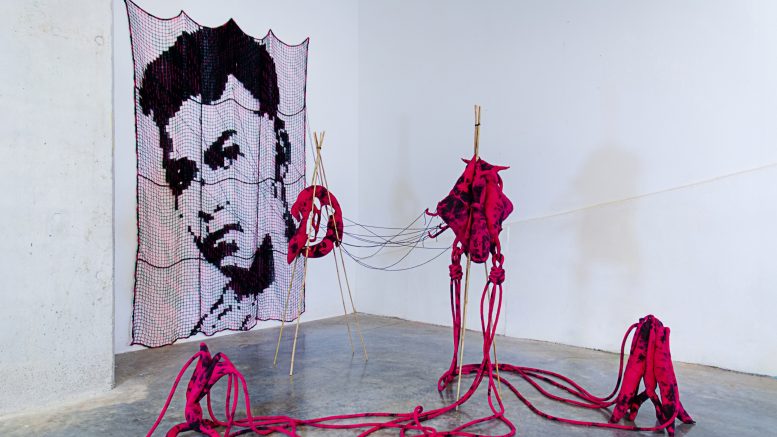Textiles is an art form steeped in history and culture — the materials used, the method of production and the subject matter that are depicted all come together to tell a larger story.
In his exhibition Next Door, Around the Corner, Inside the Bathhouse, By the Sea and Back at the U of M, Chicago-based artist Jade Yumang used textile art to explore Filipino history, cultural identity and his own past. His use of crimson and black lace portraits and sprawling, dendritic soft sculptures create a visually and texturally striking scene in the gallery.
Born in the Philippines, Yumang has lived in Dubai, Vancouver and New York. He is currently a fibre and material studies professor at the School of the Art Institute in Chicago. According to Yumang, his migratory past inspired much of his artistic work, including this series on campus.
“With this series specifically, I wanted to kind of look at just how culture kind of moves […] specifically the Filipino diaspora. But I didn’t want it to be too obvious initially, so I wanted to kind of mesh into maybe what I call strange bedfellows or disparate things and see whether or not they kind of intersect or relate,” he said.
“And a lot of fibre history, in a lot of ways, kind of like what I’ve been through in terms of traveling a lot or immigrating, a lot of fibre history has kind of intersected with different cultures, right? Just think of like the history of the Silk Road. And so I was always kind of curious, ‘oh, what can filet lace do to tell some type of story?’”
Yumang’s work prominently features filet lace, a type of embroidery where patterns are sewn onto a hand-knotted net-like grid. Yumang pointed out while the Philippines have a tradition of weaving and net-making due to its fishing culture, filet lace was introduced to the region during Spanish colonization.
However, the production of these works of art in the Philippines historically did not belong to the people. Instead, the art form was in large shaped by Spanish colonization, and later American imperialism.
“For the most part, [filet lace] was an enforced pattern to the Filipino craftspeople, primarily following European motifs, either geometrical, pastoral or religious. I think the only thing that slightly changed is the use of material, primarily using cotton and piña [pineapple] fibre,” Yumang explained.
“Then it developed even further when the Americans occupied the Philippines between 1898 to 1946 […], but also other parts of Asia like Taiwan, created a piece called army navy tablecloth, and it’s a mixture of filet lace and embroidery work […] American troops who were stationed in the Philippines and the islands would buy this to bring back home. So again, it was always making it for someone else, and I, in a lot of ways, wanted to reclaim that.”
Yumang continues to work with filet lace, but he also has plans of growing a natural dye garden and spinning yarn with banana fibre and American and Canadian wool to reflect his diverse upbringing.
“Right now I’m just playing like, ‘oh, you know, I grew up in so many places. Can I, in some ways, use different materials from all the places I grew up? And turn them into one string of yarn?’ And then make something out of that. Again, my history [is] embedded within the fibre,” he said.
Next Door, Around the Corner, Inside the Bathhouse, By the Sea and Back is on display at the School of Art Gallery on campus from Nov. 21, 2024, to Feb. 1, 2025. Learn more about Jade Yumang and his work by visiting jadeyumang.com.


